Leslie Graff
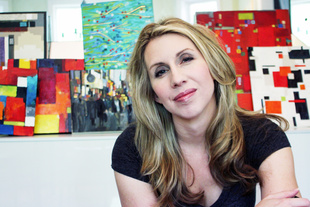
When did you begin to define yourself as an artist?
Creating has always been a big part of my life since childhood in one form or another. My parents were saintly patient and lived through many creative messes and exploits. I started taking museum and private lessons when I was in elementary school. I sort of walked away from it during my college years, pursuing other academic loves, but even then I chose fields that had strong creative components and that allowed me to integrate art into them. My art didn’t like playing second fiddle and sort of pushed its way back to the forefront.
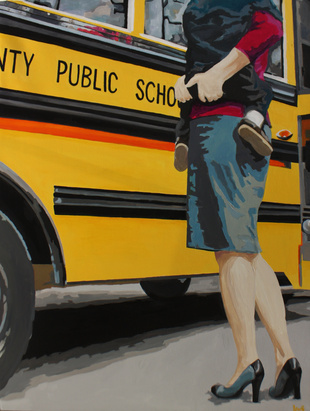
I did my first solo show eight years ago, but I’d say it’s really been in the last five years that being an artist has sort of overshadowed the other things people knew me as. Growing up, I thought I was too normal to be an artist, and now I think I am certainly too crazy to not be one. I never go on vacation without a sketchbook and generally without a box of paints. Painting as work always kind of makes me laugh—while it takes a lot of effort, it’s hard to classify it as work when it’s something you want to do more than eat or sleep.
In your domestic series, why did you choose to paint the women without faces, in pencil skirts and in heels?
My decision to crop the figures was a very deliberate one I made early in the series. It’s actually a self-portrait series, but I wanted to make the figures more universal. I wanted to use the irony of presenting an intimate setting, yet removing the most intimate, identifying feature of the figure. My intention was to focus on the work or the action and play with this concept of identity driven by the tasks and roles we do.
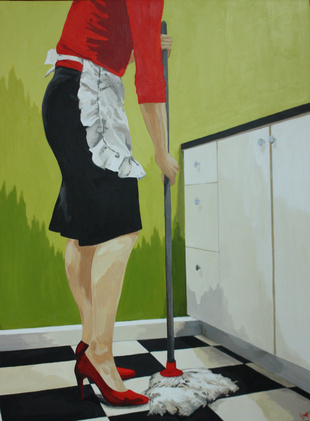
Also, the shots take the vantage point of my children. I dress the figures up to question the importance or significance we give to domestic tasks, juxtaposing the more elegant with the mundane, and also to blur the historical time period. I want to leave people questioning what decade the piece is set in and what it means.
Is there a particular piece that you consider your personal best? Why?
Well, I am kind of a flavor of the week girl, so my favorites are different on any given day. The art on my walls changes constantly. At present, my favorite in the domestic series is “Welcome Home.” I like it from a technical standpoint, but it’s also significant to me because of where I took the study shot, and the fact that the bus was from the district where I taught school fifteen years ago. It also came toward the end of the series when I finally felt I had sort of done what I set out to do with the series.
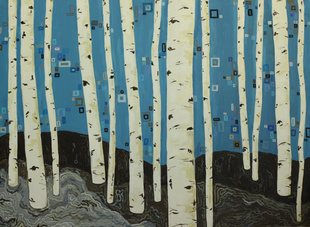
“Chain Garden II” and “Reaching Tree” are two in my organic collection that are favorites I have refused to sell. There is something about the first piece you do in a series that is different, something in that initial working out of an idea.
I am really excited about the new mixed media series I am working on. “Volumes On White” is a new piece and I would also consider it one of my best works. This piece explores the multiplicity of thoughts and ideas.

When someone looks at the paintings in your domestic series, what do you want them to convey?
I wanted them to be discussion pieces. To say I wanted to make a social statement wouldn’t be accurate. I don’t want everyone to take away one thing from the paintings. This is where art is essential—it interacts with the viewer’s own experience to create some entirely unique feeling. I wanted a series that was broad enough such that everyone could have some connection with at least one piece in the series.
My aim was to ask social questions and to ask personal questions. I wanted people to dig deeper into their own conscious or subconscious thoughts about family life in a larger context as well as in a more personal sense.
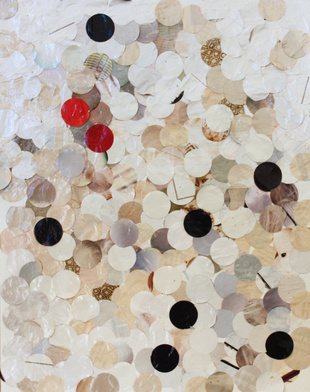
Having an academic background in family studies, I’ve noticed that there have been a lot of cultural shifts in how we view family life. We outsource more and more of the things that used to be contained in our domestic spheres, but I don’t think we often consciously explore what this means to the nature of families. Or where meaning in our relationships comes from. My intention was to create something thought-provoking and not sentimental.
I invite people to share their reactions to the pieces with me. It makes the series almost feel like a loose qualitative research project.
The pieces all use symbols to explore deeper themes, like “Easy As Pie,” which is about how we divide up our resources, our time, our energy, all these finite commodities we trade in our family life daily. “Who’s There” uses the analogy of a corded phone to beg questions about emotional and physical presence. “It’s a Treat” explores attitudes toward value/enjoyment of family time in a more leisure-based, individualistic culture. The titles are all phrases and intended to be sort of ironic and loaded.
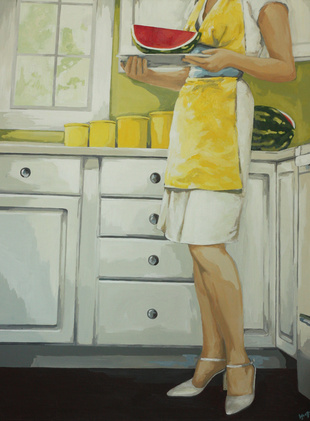
As a woman, I wanted to paint the entire series focused on women and I hadn’t really seen domestic work featured prominently in art, so that was important.
On your website you mention that you have travelled to numerous countries doing humanitarian work as a child life specialist. What countries and what kind of work did you do?
My other great love is child development; I taught family studies at the college and university level before I had children and continue to stay active as a child life specialist, a clinical specialty providing psychological preparation and therapeutic play to children in hospital settings.
I work with the Vascular Birthmarks Foundation, providing psychosocial guidance to families around the world living with visible differences.
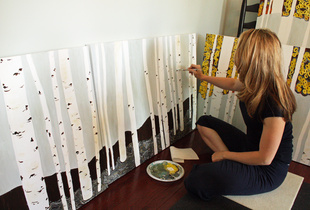
I am also able to do volunteer medical missions with Operation Smile, which provides free surgeries for children around the world, treating cleft lips/palates, burns, and other craniofacial issues. I have been to Kenya, Morocco, Siberia, Philippines, and Jordan, and a few of those places more than once.
I prepare all the children for surgery and maintain a hospital playroom. So you will always find me stockpiling toys from thrift shops for my next mission. It is one of the things I live for. I am a firm believer in using our time and talents to improve the lives and opportunities of others.
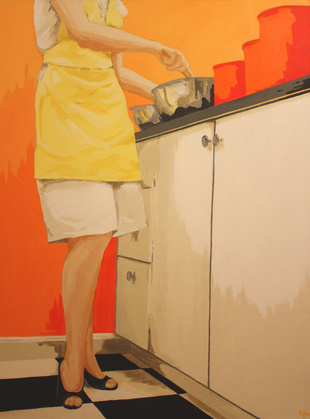
How have you been able to balance being a wife, mother, and artist?
My philosophy of life is generally to fill it all the way up with good things such that some are sloshing over the side. My weakness is that I tend to keep too many irons in the fire. My to-do list rarely has less than seven major things on it at a time. The key to working in a lot of things is to do it in shifts and seasons, never all at once. That being said, I am not afraid to let a ball drop here or there. I try not to be too hard on myself.
I think it works for me because I am a very flexible person by nature and not a perfectionist. I thrive and am most productive in an unstructured time environment, which lends itself very well into meshing those roles. Work and home being in the same place also allows me to maximize my productivity. I am constantly evaluating how much time and energy I allow myself to invest in my art, and when I say constantly, I mean literally on a daily basis.
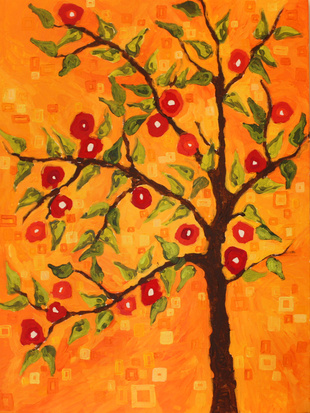
As I have become much busier with my art, maintaining emotional presence is actually one of the hardest things. The creative process can be very consuming and it’s very alluring to really want to jump in with both feet, but staying tethered to other priorities and responsibilities is a necessity for me. I constantly feel I have to swim carefully in strong currents.
If I’m not careful, I can sort of operate in autopilot, where my mind is kind of distracted working out various ideas and images in the back of my head and I’m not really connected to what I am doing through the day.
So, to minimize that, I generally paint at night, when my children are asleep. While I like them to see me paint, the truth is they need me during those waking hours, and I value and guard my time with them. I’m not willing to give up being the mom who has fresh cookies waiting at the bus stop or who’s willing to drop it all to read books in the hammock.
I generally need at least a two-hour stretch to be productive at all. I probably tend to cheat sleep probably more than I should—it’s tough when I can’t start to paint until 8:30 p.m. and I have been up since 5:45 a.m.
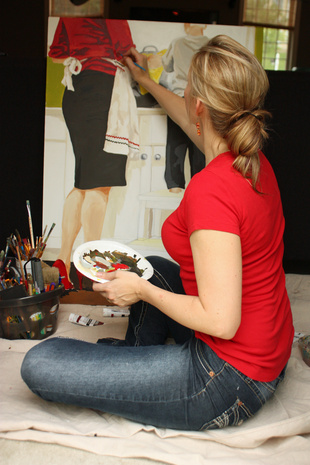
Beyond the creating, the business aspects can be quite time consuming. I tend to do other business tasks—accounting, ordering, shipping, emails, calls, working with clients—when my youngest is down for a nap. Even that load is getting overwhelming and I have been trying to find ways to outsource more of those tasks.
I am very upfront with people that my family comes first. I make no apologies for having a loose timeline for commissions and shipping. I am a huge advocate for changing our work/family culture to be more family friendly and flexible. So this is something I don’t compromise on. People respect that.
What is your artistic process?
I always keep a sketchbook around. Most ideas need time to percolate until they are ready to come out. I tend to always have things running in the back of my head all the time. I always have more ideas and plans than I have time to explore, especially right now. So I have to prioritize.
I have a good size studio in my home, but this tends to be as much where my supplies and paintings live as anything.
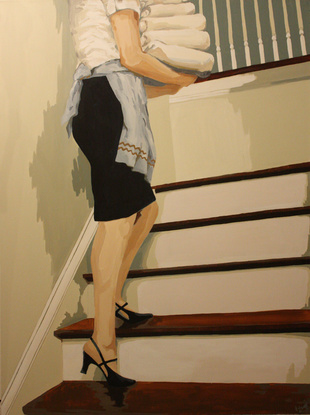
I work all over: inside, outside, and a lot of the time I sit on the floor and paint flat instead of using an easel which is kind of unusual but I like being able to move around the piece and it probably a throwback from working with children. It’s not unusual to see brushes and paints and temporary painting spots set up in just about any room of my house. I tend to move around in order to hang out with my husband while I work.
For the domestic series, I take photo studies that I paint from. It’s a total trip getting the camera/tripod set up, getting the right corner of the house, incorporating the historical artifacts into the piece (like the vintage aprons my great grandmother embroidered or hand-me down mid-century furniture pieces), getting myself dressed (sometime my youngest son too) and posed in the perfect positions, and then taking the pictures via remote. Most of the thirty pieces are set at my home, a few at my parents’ or best friend’s, and two in other locations.
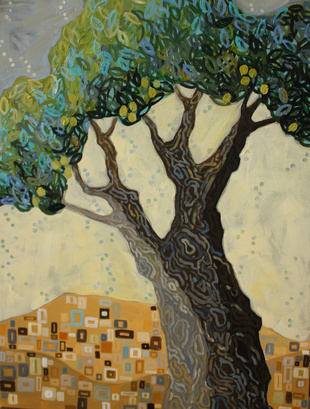
So there is actual more authenticity to the scenes than you’d expect. People who know me well can tell you they see those clothes, they’ve eaten at that table or climbed those steps in the paintings.
I think I am little different in that I adamantly refuse to paint only one style or subject matter. In this I am very much a nonconformist. I like to question our traditional expectations of artists. Again I think it’s that unstructured part of me that needs this freedom—the one constant I need in life is change. It sounds crazy but it’s almost an academic or technical mental challenge for me to switch gears in and out of various styles and see the breadth of work I can create. The challenge of working in different directions keeps me fresher. I am not really willing to be one type of painter—it goes against the nature of creativity to me.
Why do you work primarily in acrylics?
I have used acrylics for a few decades. I first started acrylics when I was twelve and instantly fell in love. I knew even in high school that I preferred painting to drawing and acrylics in particular. I actually think you can often tell a lot about someone’s larger personality or creative style by the mediums they use. I think you tend to settle into the medium that sort of fits the way you think.

I always say I am not deliberate enough or enough of a planner to be good at watercolors or patient enough for oils. I tend to layer a lot by nature so the fact that they dry fast is important to me. Acrylics have a lot of flexibility and are known for having bright colors, which fits well with my style. I have painted through pregnancies and always in a house with small children, so acrylics are a pretty safe medium, not as toxic as other things. It’s nice that my children can use them right alongside me; my boys have all been painting with acrylics since they were a year old.
How has your faith and knowledge of the gospel influenced your work?
My faith is so ingrained in the nature of who I am and what I do. I was raised with the belief that values creation as an eternal principle and I grew up in a family where we were taught to be useful and productive. I know my faith influences the way I view the world and the things that are important to me, which I know shows in the themes of my work. I always explore relationships, connections, and meaning in my pieces, be they figurative, abstract, or organic. I see the opportunity to create and my inspirations to paint as profound blessings.
How do you balance being LDS and being an artist?
My art very much comes out of my identity and my beliefs cannot be separated from it. They seem to coexist relatively peacefully. I think the hardest thing as an artist is just staying grounded to reality in your relationships and commitments.
The church time demands are high, especially where we live here in Massachusetts, so in that sense I think I have limitations other artists don’t have.
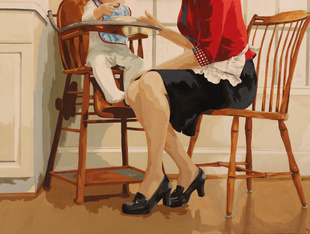
How do you see your art helping build the kingdom?
I think we should always be contributing with whatever knowledge and talents we have. Sharing the gospel is not always overt. It is much more about how we live our lives, what we stand for, and how we influence people around us. I hope my art reflects my sense of purpose and belief and desire to influence people for good.
I think a lot of art speaks in spiritual ways or contributes to our experience but that does not necessarily mean the subject matter will be overtly religious. People and relationships are the things that matter most to me. There is a lot of symbolism and meaning in my pieces which has more personal and religious significance to me.
I think that so much of emotion, testimony, and experience can’t be translated simply into words or concrete images. I like the ambiguity of abstraction and symbolism because to me it values the individual, in letting them find a certain amount of their own meaning in the piece.
I see God in so many of the details of my life. In my organic and abstract work I use small things to composite into a whole; this reflects my belief that as individuals we have the ability to create powerful things and influence others with small actions. I hope to help people find beauty, meaning, and purpose in their experiences, both through my interactions with them and through my art. ❧
